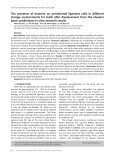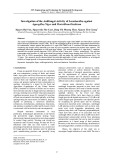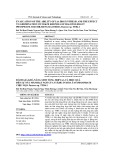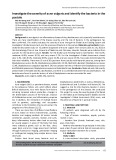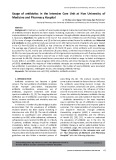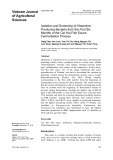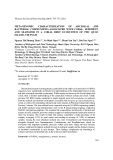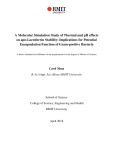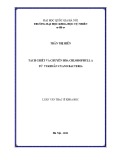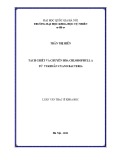Ubiquitin C-terminal hydrolase-L1 (Uch-L1) correlates with gonadal transformation in the rice field eel Jinhua Sun, Xuan Shang, Yihao Tian, Wei Zhao, Yan He, Ke Chen, Hanhua Cheng and Rongjia Zhou
Department of Genetics and Center for Developmental Biology, College of Life Sciences, Wuhan University, China
Keywords fish; gonadal transformation; spermatogenesis; ubiquitin C-terminal hydrolase-L1
Correspondence R. Zhou and H. Cheng, Department of Genetics and Center for Developmental Biology, College of Life Sciences, Wuhan University, Wuhan 430072, China Fax: +86 27 68756253 Tel: +86 27 68756253 E-mail: rjzhou@whu.edu.cn, hhcheng@whu.edu.cn
(Received 10 September 2007, revised 11 November 2007, accepted 15 November 2007)
doi:10.1111/j.1742-4658.2007.06194.x
The ubiquitin–proteasome pathway is crucial for a variety of biological processes, including spermatogenesis. Ubiquitin C-terminal hydrolase-L1 (Uch-L1) is thought to associate with monoubiquitin to control ubiquitin levels. Here, we report the identification of Uch-L1 cDNA from the testis of the rice field eel, a natural sex reversal vertebrate, by using cDNA microarray analysis. Uch-L1 encodes a protein of 220 amino acids that shows high homology to Uch-L1 of vertebrates, especially fish species. Both mRNA and protein are mainly expressed in testis, ovotestis and ovary, as well as in the brain. Immunohistochemistry analysis revealed dif- ferential expression of Uch-L1 in three kinds of gonads. In the ovary, expression of Uch-L1 was observed mainly in the developing ovary and slightly in the mature ovary. In ovotestis during the intersex stage, Uch-L1 was expressed in the male gonad epithelium and degraded ovary. In testis, expression was observed in developing germ cells, including spermatogonia and spermatocytes. Furthermore, Uch-L1 was upregulated during gonadal transformation, especially from the beginning of the intersex stage onwards. Native-PAGE showed that Uch-L1 underwent dimerization and oligomerization in gonads, and that the relative level of dimerization ⁄ oligo- merization decreased during gonadal transformation. Simultaneously, ubiquitin polypeptide expression was upregulated during this process. These results suggest that Uch-L1, via the ubiquitin–proteasome system, may play an important role not only in gametogenesis, but also in the gonadal transformation process in the rice field eel.
ases that hydrolyze ubiquitin molecules from poly- ubiquitin chains after their release from target proteins [3].
Abbreviations Uch, ubiquitin C-terminal hydrolase; Uch-L1, ubiquitin C-terminal hydrolase-L1; UCH-L1, human ubiquitin C-terminal hydrolase-L1.
FEBS Journal 275 (2008) 242–249 ª 2007 The Authors Journal compilation ª 2007 FEBS
242
Ubiquitin is a 76 amino acid polypeptide that, as its name implies, is ubiquitously distributed and highly conserved throughout eukaryotic organisms, and plays a crucial role in a wide variety of biological processes, through covalently attaching to lysine residues of tar- get proteins [1]. Several ubiquitin molecules, in the form of a multiubiquitin chain, are conjugated to a substrate. Multiubiquitination serves mainly to label the substrate for degradation via the 26S proteasome system [2]. The cellular ubiquitin balance is controlled by release of ubiquitin from uniquitin-conjugated unwanted, misfolded, or damaged polypeptides within the cell by deubiquitinating enzymes, a family of prote- Ubiquitin C-terminal hydrolase-L1 (Uch-L1) is one of many deubiquitinating enzymes, and is selectively and abundantly expressed in neuron cells, testis and ovary [4,5] to hydrolyze ubiquitin from ubiquitinated cellular proteins, thereby deciding protein fate and degradation, or regulation of biological processes via the ubiquitination signal pathway. In addition to its hydrolase activity, Uch-L1 has also been shown to have in vitro ligase activity, and this ligase activity is correlated with dimerization of the enzyme, which may
J. Sun et al.
Uch-L1–ubiquitin and sex reversal
Fig. 1. Structural modeling and phylogenetic analysis for Uch-L1 of the rice field eel. The structure was predicted by the Swiss-Prot server (A). Uch-L1 was composed of two lobes, one consisting of five a-helices (a1, a3, a4, a5, and a6), and the other consisting of two a-helices (a2 and a7) and six b-strands (b1–b6). The phyloge- netic tree (B) was constructed using the neighbor-joining method. The GenBank accession numbers are as follows. Uch: fruit fly, NP_476940; Nile tilapia, BAC22191. Uch-L1: rice field eel, EU095955; human, NP_004172; mouse, NP_035800; Norway rat, NP_058933; pig, NP_998928; chicken, NP_001073681; clawed frog, NP_001011321; zebrafish, AAN18025. Uch-L3: human, NP_005993; mouse, AAF64193; Norway rat, XP_575294; pig, NP_001070695; chicken, NP_990156; clawed frog, CAJ83746. Uch-L4: mouse, NP_291085; clawed frog, NP_001017120.
The rice field eel, Monopterus albus,
explain why a common polymorphism of Uch-L1 (S18Y) is linked to a reduction in the risk of Parkin- son’s disease [6]. Recent studies suggest that Uch-L1 associates with monoubiquitin and prolongs ubiquitin half-life in neurons [4]. In mouse testis, Uch-L1 protein is localized in germ cells, and is essential for the early apoptotic wave of germinal cells and for sperm quality control during spermatogenesis [7]. Overexpression of Uch-L1 in transgenic mice leads to male infertility, due to blockage of spermatogenesis [8]. In mouse ovary, Uch-L1 is selectively detected on the plasma mem- brane, as a candidate for sperm–oocyte interactive binding or a fusion protein, to avoid polyspermy [5]. During porcine fertilization, Uch-L1 was detected in the oocyte cortex but not on the sperm surface, and was partially degraded within 6–8 h after fertilization, which suggested that Uch-L1 was involved in sperm– zona interactions and antipolyspermy defense [9]. Uch- L1 was also reported to be involved in oogenesis and odor recognition in toads [10] and teleosts [11]. Inter- in the temperate wrasse, Halichoeres poecil- estingly, opterus, which naturally undergoes sex reversal from female to male, Uch-L1 was suggested as a putative factor involved in sex differentiation of the fish [12]. However, biological roles and mechanisms in the sex- ual development of Uch-L1 need to be further studied. is a specific model vertebrate for studies of sexual development, because of its naturally occurring sexual transforma- tion from female to male via intersex, its small gen- ome, and its particular evolutionary history [13,14]. Using the special characteristic of sex reversal of the species, we report here the identification and character- ization of Uch-L1 and its role in gonadal transforma- tion.
two a-helices
Results
Identification of the evolutionarily conserved Uch-L1
gene sequence predicted a protein of 220 amino acids. Uch-L1 is composed of two lobes, one consisting of five a-helices (a1, a3, a4, a5, and a6), and the other consisting of (a2 and a7) and six b-strands (b1–b6) (Fig. 1A). Between the two lobes is a cleft in which the putative catalytic triad of C87, H159 and D174 resides, as determined by sequence similarity with other known Uch proteins. The overall architecture of eel Uch-L1 closely resembles that of human ubiquitin C-terminal hydrolase-L1 (UCH-L1).
Uch-L1 was upregulated during gonadal transformation of the rice field eel
FEBS Journal 275 (2008) 242–249 ª 2007 The Authors Journal compilation ª 2007 FEBS
243
To analyze expression patterns of Uch-L1, we carried out RT-PCR using RNAs isolated from gonads and other tissues. Uch-L1 was dominantly expressed in tes- tis and ovotestis, slightly in ovary and brain, but not in heart, liver, kidney, or spleen (Fig. 2A). Northern blotting analysis confirmed the expression pattern; a To search for genes involved in sexual differentiation, we utilized the natural sex reversal trait of the rice field eel, a teleost fish, as a new model system for vertebrate sexual development [14,15]. We differentially screened a swamp eel testis cDNA library on microarrays using probes from testis, ovotestis and ovary mRNA respec- tively. A cDNA that was found to be differentially expressed among testis, ovotestis and ovary showed the greatest sequence similarity to vertebrate Uch-L1, especially to the fish branch (Fig. 1B). Uch-L1 of the rice field eel and the Nile tilapia was most closely related among the 18 samples (10 species). The Uch-L1
J. Sun et al.
Uch-L1–ubiquitin and sex reversal
C
A
B
Fig. 2. RT-PCR and Northern blot analysis of Uch-L1 of the rice field eel. (A) Semiquantitative RT-PCR of Uch-L1 of the rice field eel showed its dominant expression in three kinds of gonads and a faint band in the brain. (B) Northern blot analysis of Uch-L1 expression in testis, ovo- testis and ovary of the rice field eel, and rRNAs used as a loading control. (C) Real-time fluorescent quantitative RT-PCR of Uch-L1 of the rice field eel showed its expression in three kinds of gonads and brain. The expression of Uch-L1 relative to Hprt in ovary, ovo I (ovotestis I, pre- intersex stage, most of the gonad is ovary; testis beginning to develop), ovo II (ovotestis II, medium intersex stage), ovo III (ovotestis III, postintersex stage, most of the gonad is testis), and testis measured by real-time RT-PCR.
intersex stage, Uch-L1 was expressed in the male gonad epithelium and degraded ovary (Fig. 4D). In testis, expression signals were observed in developing including spermatogonia, and spermato- germ cells, cytes (Fig. 4G).
Fig. 3. Expression analysis of Uch-L1 proteins of the rice field eel by western blots using antibody to Uch-L1 showed dominant expression in ovotestis and testis. b-Actin protein was used as an internal control. The molecular mass of the protein is shown on the right.
Dimerization and oligomerization of Uch-L1 in gonads
Native-PAGE was used to determine whether Uch-L1 forms dimers or oligomers in gonads. When equal amounts of Uch-L1 from three kinds of gonads were sampled as a control (SDS ⁄ PAGE; Fig. 5B), native- PAGE analysis showed that dimers and oligomers of Uch-L1, as well as monomers, were observed in the three kinds of gonads. However, rates of dimerization and oligomerization were high in ovary and lower in ovotestis, whereas monomers were mainly formed in testis, which suggested that the dimerization ⁄ oligomeri- zation level of Uch-L1 decreased during gonadal trans- formation from female to male (Fig. 5A). main band of 1.2 kb was observed (Fig. 2B). Further- more, accurate quantitative analysis was carried out by real-time fluorescent quantitative RT-PCR, which showed that the expression level of Uch-L1 in ovotes- in tis I increased (cid:2)10-fold as compared with that ovary (Fig. 2C). The expression level of Uch-L1 did not change significantly from ovotestis II to testis. Moreover, to investigate protein expression, western blot analysis was carried out, which showed a band of 26 kDa and further confirmed the expression pattern of the gene at the protein level (Fig. 3).
Ubiquitination was upregulated during gonadal transformation Cellular localization of Uch-L1 protein in germ cells
FEBS Journal 275 (2008) 242–249 ª 2007 The Authors Journal compilation ª 2007 FEBS
244
The main role of ubiquitin is as a targeting signal for degradation of ubiquitinated proteins. Coimmuopre- cipitation was used to test the interaction between Uch-L1 and ubiquitin, and showed that Uch-L1 could bind to and interact with monoubiqutin in the rice field eel (Fig. 6). To test whether ubiquitination was sections Immunohistochemical analysis of gonadal revealed different localizations of Uch-L1 in three kinds of gonads. In the ovary, localization of Uch-L1 was observed mainly in developing ovary and slightly in mature ovary (Fig. 4A). In ovotestis during the
J. Sun et al.
Uch-L1–ubiquitin and sex reversal
A
B
C
D
E
F
G
H
I
Fig. 4. Localization of Uch-L1 by immuno- histochemistry assay with antibody to UchL1. In the ovary (A), Uch-L1 localized especially in developing ovary, but only slightly in mature ovary. In the ovotestis (D), Uch-L1 was mainly localized in the degraded ovary and in the gonad epithelium. In mature testis (G), Uch-L1 was mainly localized in spermatogonia (triangle) and spermatocytes (arrow). Signals are also labeled with white triangles. Hematoxylin– eosin-stained sections (C, F, I) and the nega- tive control sections incubated with preim- mune serum instead of anti-UCH-L1 (B, E, H) were also included. O, mature ovary; Odv, developing ovary; Odg, degraded ovary; T, testis. (A) Magnification ·100; (B, C) Magnification ·400.
A
B
showed that monomers
Fig. 6. Uch-L1 binds to monoubiquitin in the rice field eel. Co- immunoprecipitation was performed with antibody against Uch-L1 (left) or monoub (right), and then cell lysates were analyzed by the western blotting with antibodies against Uch-L1 and monoub respectively.
in three kinds of gonads,
Fig. 5. Native PAGE analysis and dimers ⁄ oligomers of Uch-L1 existed in all gonads. Monomers of Uch-L1 were predominant and dimers ⁄ oligomers of Uch-L1 also existed in all gonads (A). Uch-L1 in ovary showed significant amounts of oligomerization and dimer- ization, and the ratio between dimers and monomers decreased during the sexual transition from female to male. (B) Equal amount of Uch-L1 (SDS ⁄ PAGE) used as a control to eliminate the faulty in three results from the difference of Uch-L1 expression level kinds of gonads.
polyubiquitin expression were relatively low in ovary, whereas during gonadal transformation, expression of both monoubiquitin and polyubiquitin was upregulat- ed in ovotestis and maintained at a high level in testis (Fig. 7).
Discussion
FEBS Journal 275 (2008) 242–249 ª 2007 The Authors Journal compilation ª 2007 FEBS
245
M. albus taxonomically belongs to the teleosts, the family Synbranchidae of the order Synbranchiformes (Neoteleostei, Teleostei, Vertebrata). This freshwater involved in sexual transformation of the rice field eel, both monoubiquitin and polyubiquitin levels during sexual transformation were examined by western blot analysis, which showed that both monoubiquitin and
J. Sun et al.
Uch-L1–ubiquitin and sex reversal
of level
Fig. 7. Western blot analysis of both monoubiquitin and polyubiqu- itin expression levels in the gonads of the rice field eel. Proteins were isolated from ovary, ovotestis and testis, respectively, of the rice field eel. b-Actin protein was used as an internal control. The molecular mass of the protein is shown on the right.
eel; (b) dimerization and oligomerization of Uch-L1 takes place in testis, ovary and ovotestis, and the dimerization ⁄ oligomerization Uch-L1 decreased during gonadal transformation from female to male; and (c) consistent with upregulation of Uch- L1, ubiquitination is upregulated during gonadal transformation, and Uch-L1 may interact first with ubiquitin, and thus join in maintaining the total ubiq- uitination level during gonadal transformation. These results suggest an important role of Uch-L1 associated with ubiquitin in gonadal transformation from female to male via intersex.
Our studies showed that the expression of Uch-L1 in gonads of the rice field eel starts to increase during sex transition and remains at a high level in the mature testis. Native-PAGE analysis indicated that there are both hydrolase activity (monomer) and ligase activity (dimers–oligomers) of Uch-L1 in gonads. The enzyme activity of Uch-L1 was mostly that of a hydrolase, because the majority of the protein is in the mono- meric form in all three kinds of gonads. Interestingly, the ratio of oligomerization (including dimerization) to monomerization decreased during gonadal transforma- tion, which showed that ligase activity seems to be more important in oogenesis, whereas Uch-L1 mono- mer and upregulated ubiquitin may play key roles in gonadal transformation from ovotestis to testis.
fish is not only an economically important species in southeast Asia for food production, but also a good model for comparative genomic studies of distantly related vertebrate processes, and sexual differentiation, because of its primitive evolutionary status, relatively small genome size, and natural sex reversal via intersex from female to male during its life cycle [13,14]. Tak- ing advantage of the sex reversal characteristic of the rice field eel, we identified Uch-L1 cDNA by testis cDNA microarray analysis, which showed high homol- ogy to Uch-L1 of vertebrates, especially fish species.
FEBS Journal 275 (2008) 242–249 ª 2007 The Authors Journal compilation ª 2007 FEBS
246
Uch-L1 is a member of the Uch family, members of which release free ubiquitin from polyubiquitin-conju- gated proteins and conjugate ubiquitin to target pro- teins, because of their ligase activity [6]. Therefore, Uch-L1 plays an important role in the maintenance of intracellular monoubiquitin levels by generating ubiqu- itin through the hydrolysis of polyubiquitinated pro- teins, and regulates the ubiquitin pathway. The main role of ubiquitin is as a targeting signal for degrada- tion of ubiquitinated proteins. The ubiquitin pathway is responsible for the proteasome-mediated turnover of short-lived regulatory proteins as well as for the degradation of misfolded, unassembled or damaged proteins that could be potentially dangerous for the cell [1,2]. The biological roles of Uch-L1 associated with ubiquitin in gonadal transformation of the rice field eel were further revealed in the present study. Our main findings are as follows: (a) Uch-L1 is upreg- ulated during gonadal transformation of the rice field Uch-L1 can bind to and stabilize monoubiquitin; this is a function of Uch-L1 affinity for ubiquitin rather than its deubiquitinating activity [4]. This inter- action between Uch-L1 and ubiquitin may, at least partly, play an important role in maintaining the intracellular levels of ubiquitin during gonadal trans- formation. Total ubiquitination during gonadal trans- formation seems to be a complex process, and other unknown factors may also play a role in maintaining the total level of ubiquitination during gonadal trans- formation. During the course of sexual transformation, ovary was gradually degraded and formed ovotestis, and male epithelium rapidly developed and was finally replaced by testis. Therefore, many proteins were degraded during the ovotestis stage; these proteins were connected with the ubiquitin 26S proteasome degradation pathway. The expression level of Uch-L1 together with ubiquitin in ovotestis was highly upregu- lated, which is essential for the start of gonadal trans- formation. Uch-L1 may be also involved in germ cell apoptosis in the rice field eel during spermatogenesis, as observed in the mouse [7]. These results suggested that Uch-L1, via the ubiquitin–proteasome system, may play an important role not only in gametogenesis, but also in the gonadal transformation process through macroregulation of hydrolase activity and
J. Sun et al.
Uch-L1–ubiquitin and sex reversal
transcriptase
RT-PCR microregulation of dimerization-dependent ligase activ- ity, in the rice field eel.
Experimental procedures
Total RNAs were isolated using Trizol, and used as tem- plates for reverse transcription using poly(T)18 primer and reverse (Promega, Madison, WI, USA). RT-PCR was used to amplify Uch-L1. PCR amplification conditions were: 25 cycles of 30 s at 94 (cid:2)C, 30 s at 64 (cid:2)C and 30 s at 72 (cid:2)C for Uch-L1; and 22 cycles of 25 s at 94 (cid:2)C, 25 s at 64 (cid:2)C and 25 s at 72 (cid:2)C for Hprt. Primers were as follows: Uch-F, 5¢-TTGGCGTGGGTGAAGTTGG-3¢, and Uch-R 5¢-CCTCACGGATTGCCTGGTTC-3¢, for Uch-L1; Hprt-F, 5¢-GAACAGTGACCGCTCCATCC-3¢; and Hprt- R, 5¢-TCTTCATCGTCTTTCCCGTGTC-3¢ for Hprt.
Animals and antibodies
The rice field eels were obtained from markets in the Wuhan area in China. Their sex was confirmed by micro- scopic analysis of gonad sections. The experiments were carried out in accordance with the International Guiding Principles for Biomedical Research Involving Animals as promulgated by the Society for the Study of Reproduction. Antibody to Uch-L1 was supplied by K. Mochida. b-Actin (sc-47778) was purchased from Santa Cruz Company (Santa Cruz, CA, USA). Antibody to polyubiquitin (D058-3) was purchased from MBL (Woburn, Japan), and antibody to monoubiquitin was supplied by S. Yokota. The second- ary antibodies conjugated with alkaline phosphatase were purchased from Pierce Company (Rockford, IL, USA).
Real-time RT-PCR
Real-time RT-PCR was used to quantify Uch-L1 expres- sion, using the multichannel RotorGene 3000 (Corbett Research, Mortlake, Australia), according to the supplied protocol. PCR cycling conditions were as follows: 5 min at 95 (cid:2)C, 45 cycles of 30 s at 94 (cid:2)C, 30 s at 62 (cid:2)C (Hprt) and 30 s at 64 (cid:2)C (Uch-L1), and 30 s at 72 (cid:2)C, in a 25 mL reac- tion mix containing 0.53 lL of SYBR Green I. Each sam- ple (at least five individuals of each sex) was analyzed three to six times. Data were produced by rotor-gene software, version 4.6. The mean percentage of the Uch-L1 relative to Hprt expression of each sex was obtained.
Testis cDNA library construction and differential screening
(Ambion, Austin,
TX, USA)
with
Northern blots were performed as routine protocols, except that hybridization at 42 (cid:2)C was performed in ULTRAhyb solution a [32P]dCTP[aP]-labeled probe. A fragment of Uch-L1 of the rice field eel (356 bp, after 59 bases from start codon) was used as the probe in the hybridization.
A testis cDNA library of the rice field eel was constructed using the SMART cDNA library construction kit, follow- ing the manufacturer’s protocol (Clontech, Mountain View, CA, USA). About 10 000 clones with insert sequences longer than 500 bp were dotted onto a Hybond N+ nylon membrane (Amersham, Chalfont St Giles, UK) by Qpix microarray (Genetix, New Milton, UK). Three micrograms each of mRNA from ovary, ovotestis and testis were reverse transcribed into respective cDNAs and labeled with [32P]dCTP[aP]. Three sets of arrays were hybridized over- night at 68 (cid:2)C with the respective cDNA probe. Differen- tially expressed clones were sequenced.
Northern blot hybridization
SDS ⁄ PAGE and native-PAGE
SDS-PAGE and native-PAGE were performed according to routine protocols. Because Uch-L1 was predicted as an acidic protein, native PAGE was used to analyze dimeriza- tion. Briefly, the 12% separating gel and 4% stacking gel without SDS was cast at room temperature. The mixture of sample with buffer (20% v ⁄ v glycerol, 0.2 m Tris ⁄ HCl, pH 6.8, 0.05% w ⁄ v Coomassie blue G-250) was loaded, and native PAGE was run at 4 (cid:2)C until the tracking dye was (cid:2)1 cm from the bottom.
Uch-L1 structure prediction and phylogenetic analysis
Western blots were performed according to routine proto- cols. Proteins of freshly obtained gonads were extracted. The whole extract was analyzed by glycine ⁄ SDS ⁄ PAGE or
A homology model of Uch-L1 based on UCH-L1 [16] was created by the server SWISS-MODEL and viewed with spdbv version 3.7. The structure of the rice field eel Uch-L1 was determined by the molecular replacement technique, using a homology model of Uch-L1 created from the atomic coordinates of UCH-L1 as a search model. The putative rice field eel Uch-L1 amino acid sequence from the nucleotide sequence of Uch-L1 was analyzed using the NCBI BlastP server. The Uch protein sequences from 10 species were aligned by clustal_x 1.8 [17]. The neighbor- joining method was used to construct phylogenetic trees with phylip (Phylogeny Inference Package, version 3.6). Bootstrap analyses with 2000 replicates for the neighbor- joining method were performed.
FEBS Journal 275 (2008) 242–249 ª 2007 The Authors Journal compilation ª 2007 FEBS
247
Western blot analysis
J. Sun et al.
Uch-L1–ubiquitin and sex reversal
a
to
transferred
National Key Basic Research project (2004CB117401), the Program for New Century Excellent Talents in University, and the 111 project #B06018. There is no financial conflict of interest.
References
1 Hershko A, Ciechanover A & Varshavsky A (2000)
Basic Medical Research Award. The ubiquitin system. Nat Med 6, 1073–1081.
0.45 lm Tricine ⁄ SDS ⁄ PAGE and poly(vinylidene difluoride) membrane (Hybond-P; Amer- sham Pharmacia Biotech) or a 0.20 lm poly(vinylidene difluoride) membrane (LC2002; Invitrogen, Carlsbad, NM, USA). The membranes were blocked with 5% low-fat milk powder in TBST (20 mm Tris ⁄ HCl, pH 7.5, 150 mm NaCl, 0.1% Tween-20), and incubated with the antibody for 1 h at room temperature and then with an alkaline phos- phatase-labeled secondary antibody. The immunoreactive signals were revealed by Nitro Blue tetrazolium ⁄ 5-bromo- 4-chloroindol-2-yl phosphate reagents.
2 Weissman AM (2001) Themes and variations on ubiqui-
tylation. Nat Rev Mol Cell Biol 2, 169–178.
3 Nijman SM, Luna-Vargas MP, Velds A, Brummelkamp
TR, Dirac AM, Sixma TK & Bernards R (2005) A genomic and functional inventory of deubiquitinating enzymes. Cell 123, 773–786.
4 Osaka H, Wang YL, Takada K, Takizawa S, Setsuie R, Li H, Sato Y, Nishikawa K, Sun YJ, Sakurai M et al. (2003) Ubiquitin carboxy-terminal hydrolase L1 binds to and stabilizes monoubiquitin in neuron. Hum Mol Genet 12, 1945–1958.
5 Sekiguchi S, Kwon J, Yoshida E, Hamasaki H, Ichinose S, Hideshima M, Kuraoka M, Takahashi A, Ishii Y, Kyuwa S et al. (2006) Localization of ubiquitin C-ter- minal hydrolase L1 in mouse ova and its function in the plasma membrane to block polyspermy. Am J Pathol 169, 1722–1729.
Coimmuoprecipitation was carried out according to a stan- dard protocol. Briefly, 50 mg of tissue specimen was broken up with forceps and homogenized in homogenizing buffer (50 mm Tris ⁄ HCl, pH 8.0, 1 mm EDTA, 1 mm phen- ylmethanesulfonyl fluoride, 5 mgÆmL)1 leupeptin, 0.25 m sucrose), using a motor-driven 1 mL glass on ice. The supernatant was collected after centrifugation for 10 min at 10 000–20 000 g, protein A ⁄ G PLUS-Agarose (sc-2003; Santa Cruz, CA, USA) was added, and the mixture was then incubated at 4 (cid:2)C for 60 min. The supernatant was collected after centrifugation for 10 min at 10 000– 20 000 g, split into two, incubated with either 1 lg of anti- body to Uch-L1 or 1 lg of antibody to monoubiquitin together with 25 lL of protein A ⁄ G Sepharose, and mixed end-over-end for 2 h on ice. After being washed with NaCl ⁄ Pi, immunoprecipitates were dissolved in SDS sample buffer, boiled for 10 min, and loaded onto a 12% SDS ⁄ PAGE gel for western blot analysis.
6 Liu Y, Fallon L, Lashuel HA, Liu Z & Lansbury PT Jr (2002) The UCH-L1 gene encodes two opposing enzy- matic activities that affect alpha-synuclein degradation \and Parkinson’s disease susceptibility. Cell 111, 209– 218.
7 Kwon J, Mochida K, Wang YL, Sekiguchi S, Sankai T,
Coimmunoprecipitation
Aoki S, Ogura A, Yoshikawa Y & Wada K (2005) Ubiquitin C-terminal hydrolase L-1 is essential for the early apoptotic wave of germinal cells and for sperm quality control during spermatogenesis. Biol Reprod 73, 29–35.
8 Wang YL, Liu W, Sun YJ, Kwon J, Setsuie R, Osaka H, Noda M, Aoki S, Yoshikawa Y & Wada K (2006) Overexpression of ubiquitin carboxyl-terminal hydro- lase L1 arrests spermatogenesis in transgenic mice. Mol Reprod Dev 73, 40–49.
An SABC staining Kit was used for immunohistochemistry analysis (Wuhan Boster Biological Technology Ltd., Wuhan, China), following the instructions of the manufac- turer. Briefly, cryosections were fixed and washed. Endoge- inhibited by H2O2. The nous peroxidase activity was sections were then blocked with goat serum and incubated with polyclonal antibody top Uch-L1 overnight at 4 (cid:2)C. On the next day, the slides were washed and incubated with IgG) and avidin–biotin– biotinylated goat anti-(rabbit peroxidase complex in turn. After being stained with diami- nobenzidine, the sections were observed under light micro- scopy.
9 Yi YJ, Manandhar G, Sutovsky M, Li R, Jona´ kova´ V, Oko R, Park CS, Prather RS & Sutovsky P (2007) Ubiquitin C-terminal hydrolase-activity is involved in sperm acrosomal function and anti-polyspermy defense during porcine fertilization. Biol Reprod 77, 780–793.
Immunohistochemistry analysis
Acknowledgements
10 Sun ZG, Kong WH, Zhang YJ, Yan S, Lu JN, Gu Z, Lin F & Tso JK (2002) A novel ubiquitin carboxyl ter- minal hydrolase is involved in toad oocyte maturation. Cell Res 12, 199–206.
11 Mochida K, Matsubara T, Kudo H, Andoh T, Ueda
H, Adachi S & Yamauchi K (2002) Molecular cloning
FEBS Journal 275 (2008) 242–249 ª 2007 The Authors Journal compilation ª 2007 FEBS
248
The authors thank Dr Kazuhiko Mochia for rabbit anti-Uch and Dr Sadaki Yokota for providing rabbit anti-monoubiquitin. The work was supported by the National Natural Science Foundation of China, the
J. Sun et al.
Uch-L1–ubiquitin and sex reversal
15 Zhou RJ, Cheng HH & Tiersch TR (2001) Differential genome duplication and fish diversity. Rev Fish Biol Fisher 11, 331–337.
and immunohistochemical localization of ubiquitin C-terminal hydrolase expressed in testis of a teleost, the Nile Tilapia, Oreochromis niloticus. J Exp Zool 293, 368–383.
12 Fujiwara Y, Hatano K, Hirabayashi T & Miyazaki JI (1994) Ubiquitin C-terminal hydrolase as a putative factor involved in sex differentiation of fish (temperate wrasse, Halichoeres poecilopterus). Differentiation 56, 13–20.
16 Das C, Hoang QQ, Kreinbring CA, Luchansky SJ, Meray RK, Ray SS, Lansbury PT, Ringe D & Petsko GA (2006) Structural basis for conformational plasticity of the Parkinson’s disease-associated ubiquitin hydrolase UCH-L1. Proc Natl Acad Sci USA 103, 4675–4680.
13 Rongjia Zhou HC & Tiersch TR (2001) Differential genome duplication and fish diversity. Rev Fish Biol Fisher 11, 331–337.
17 Thompson JD, Gibson TJ, Plewniak F, Jeanmougin F & Higgins DG (1997) The CLUSTAL_X windows interface: flexible strategies for multiple sequence align- ment aided by quality analysis tools. Nucleic Acids Res 25, 4876–4882.
14 Cheng H, Guo Y, Yu Q & Zhou R (2003) The rice field eel as a model system for vertebrate sexual develop- ment. Cytogenet Genome Res 101, 274–277.
FEBS Journal 275 (2008) 242–249 ª 2007 The Authors Journal compilation ª 2007 FEBS
249



